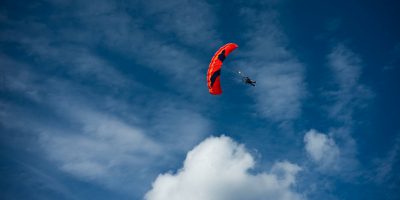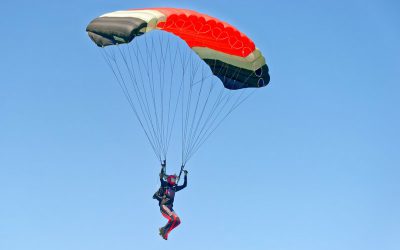What is swooping in skydiving? Skydiving swooping is all about how a skydiver lands their parachute, aka canopy. To achieve a “swoop landing,” they perform various skilled maneuvers while relatively close to the ground that increases the dive and speed of their canopy flying… and they swoop over the ground (or water!) at super-fast speeds.
Aerodynamics of Skydive Swooping
 When someone swoops, they essentially create a surge that drives the canopy towards the ground. They do this by giving a specific amount (not too much and not too little!) input to slightly stall the canopy. This stall momentarily pauses the forward motion, giving the canopy pilot an opportunity to strategically dive (so sick!). Swoopers do this with just enough time to level out and stylishly glide across the ground (or the corn, snow, or pond … anything really)! Note, this “level out” is the end of what we call a ‘flight cycle’ of the canopy.
When someone swoops, they essentially create a surge that drives the canopy towards the ground. They do this by giving a specific amount (not too much and not too little!) input to slightly stall the canopy. This stall momentarily pauses the forward motion, giving the canopy pilot an opportunity to strategically dive (so sick!). Swoopers do this with just enough time to level out and stylishly glide across the ground (or the corn, snow, or pond … anything really)! Note, this “level out” is the end of what we call a ‘flight cycle’ of the canopy.
Canopy piloting varies for every swooper because every skydiver has their own style and idiosyncrasies that work for them and their particular canopy. Different canopies will respond differently to input from the pilot, but the goal is to control the increase or decrease in forwarding speed or drive.
Canopy Flying
Why are swoop canopies so teeny tiny!? Parachute size and shape vary depending on what they’re designed to accomplish. Some are designed to be forgiving, like student canopies. Others are more advanced and less forgiving, like those used for swooping. The canopies used for swooping are referred to as more “ground hungry,” as they’re designed for speed and aggression.
What is Wing Loading?
Canopies are also called wings, probably because skydiving gives you the magical sense that you can actually fly… that YOU have wings!
Wing loading considers the total weight of the jumper at the time of the jump (body weight + gear weight) divided by the size in square feet of the wing. For example, if you are jumping a 135 sqft canopy, and you weigh 115 lbs plus 20 lbs of gear, your wing loading would be exactly 1. We would call this a 1:1 ratio.
Swoopers, especially the more advanced folks, will have a much higher (more advanced) wing loading. Say, jumping an 89 sqft canopy and having a total weight of 200 lbs, resulting in a wing loading of 2.25. A higher wing loading means the canopy descends faster. Imagine dropping a little army guy with a big ole parachute, and then a little army guy and a tank on a little parachute. The tank guy is definitely getting to the ground first!
Swooping for Fun and Competition!
 Canopy piloting is an extremely competitive discipline in skydiving. The competitions typically take place on a course set up on water, usually a pond. The course consists of precisely-located floating buoys that each competitor must navigate.
Canopy piloting is an extremely competitive discipline in skydiving. The competitions typically take place on a course set up on water, usually a pond. The course consists of precisely-located floating buoys that each competitor must navigate.
Swoopers make a dramatic entrance that spectators love! In fact, swoop competitions have brought the extreme sport of skydiving to ground level where it can be appreciated on a whole new level.
Speed, accuracy, distance, and freestyle are all components of competition for canopy pilots.
Speed:
Who can get through the course the fastest? Remember to stay on track and not bump into any buoys!
Accuracy:
Swooping across the water and focusing on a target located on the other side, all while trying to not smash into the water.
Distance:
you can avoid the water and the buoys, but can you avoid the ground? The distance portion of the competition seeks to find who can go the furthest without touching anything other than that sweet, sweet air.
Freestyle:
Can you avoid the ground, the water, the buoys, AND do some nifty tricks, all at the same time? Freestyle canopy piloting means you aren’t just focused on flying level, but also on turning 180 degrees around (like an owl) or achieving some nifty maneuvers with your hands – it’s wild!
When Can You Swoop?
When you can, or rather when you should, start swooping varies for everyone. There are skydivers with thousands of jumps who have no interest in it, and choose to pursue other skydiving disciplines. And, of course, there are skydivers who want to swoop from day one. But these eager beavers need to slow their role! There’s so much to learn and become comfortable and confident with before even thinking about swooping.
Humility goes a long way in skydiving. So, truth talk: ideal swoopers have awesome depth perception, impeccable body awareness, and a huge desire to learn from others. Swooping (while when done correctly is freakin’ sweeeet) inherently has a higher risk factor. This is why there are specific courses and camps to get better at swooping, these go from the novice level to advanced.
Put simply, a student canopy is like a soccer mom’s minivan while a canopy designed for swooping (even the most docile of them) is like a motorcycle. Until you can safely pilot and land the minivan canopy let’s keep the motorcycle in the garage. You catch our drift?
If swooping (or being an awesome skydiver in general) is a goal of yours, say YES and embark on the best adventure of your life today! Jump with us!!
Copyright © 2025, Skydive Monroe, All Rights Reserved.
DropZone Web Design & Marketing by Beyond Marketing, LLC



